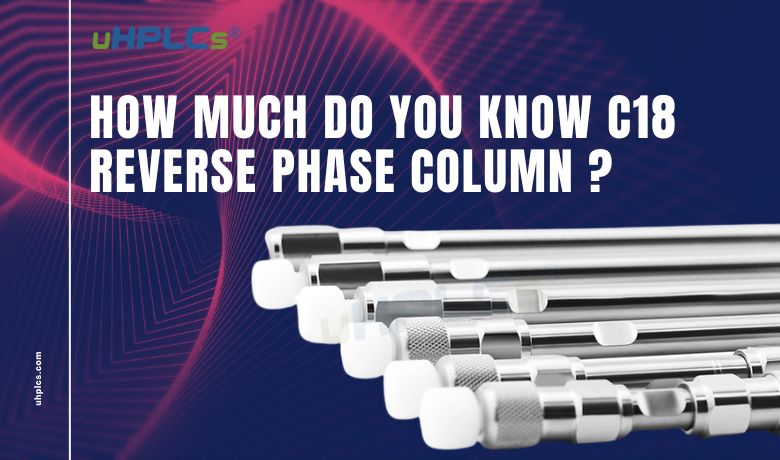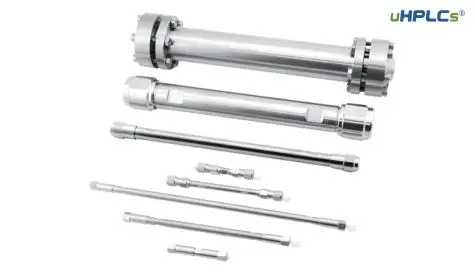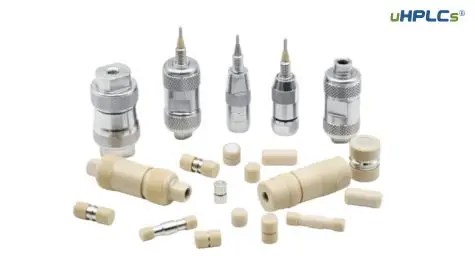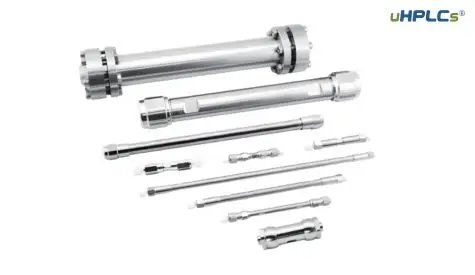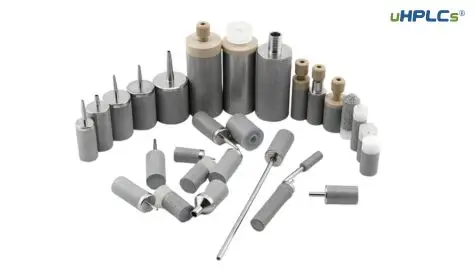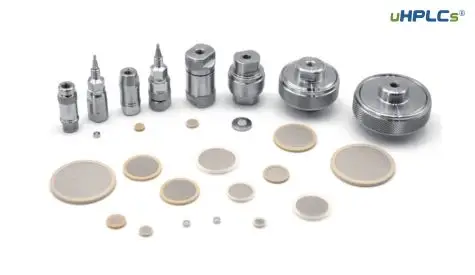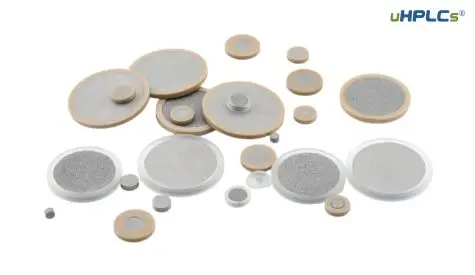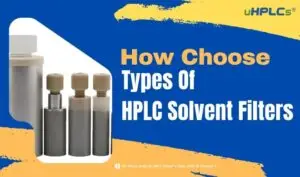High-Performance Liquid Chromatography (HPLC) 101
High-Performance Liquid Chromatography (HPLC) is a powerful technique used to separate and analyze the components of a mixture. Here’s a quick breakdown:
- The Process: Imagine a pressurized liquid (mobile phase) carrying your sample mixture through a tube packed with a special material (stationary phase). Different components in the mixture interact with the stationary phase to varying degrees, causing them to travel at different speeds through the column. This separation allows them to be collected and analyzed individually.
- The Power: HPLC is known for its high resolution, meaning it can separate very similar compounds. It’s also quite versatile and can be used for a wide range of samples, from pharmaceuticals to food products to environmental pollutants.
Why Should Choosing Right C18 HPLC Column
The HPLC column acts as the battleground for this separation. Choosing the right one is critical for successful analysis. Here’s why:
- Specificity: Different column packings have varying affinities for different types of molecules. The right column ensures your target components interact and separate effectively.
- Resolution: A good column choice maximizes the separation between closely related compounds, allowing you to see them as distinct peaks.
- Efficiency: The column should allow for efficient separation within a reasonable time frame.
Imagine using a net with big holes to catch fish of all sizes.
You wouldn’t catch the small ones, right?
Similarly, the wrong column wouldn’t allow you to distinguish subtle differences between your target molecules. By selecting the right column, you ensure your HPLC analysis is accurate and informative.
So let’s check some tips about C18 Reverse Phase Column, Then Hope will be helpful for your got right choosing idea.
Understanding C18 Reverse Phase Columns
HPLC utilizes two main separation modes: normal-phase and reversed-phase. This section dives into the world of reversed-phase chromatography, specifically focusing on C18 columns.
Reverse Phase Chromatography: A Twist on Affinity
Traditional chromatography relies on a polar stationary phase attracting polar analytes and repelling non-polar ones (normal-phase). Reversed-phase chromatography flips the script. Here’s the key concept:
- The Gist: The stationary phase is hydrophobic (water-hating), while the mobile phase is a mixture of water and organic solvents (more water-loving).
- Selective Attraction: Analytes with more hydrophobic character (think oil) interact more with the stationary phase, causing them to elute (flow out) slower. Conversely, more polar analytes (think vinegar) prefer the mobile phase and elute faster.
This creates a separation based on hydrophobicity, allowing you to isolate and analyze compounds with varying degrees of “water-shyness.”
C18 Columns: The Workhorse of Reversed-Phase HPLC
C18 columns are the most widely used type in reversed-phase chromatography. Here’s what makes them special:
- The Packing Punch: C18 stands for octadecylsilane, which essentially means a long chain of 18 carbons (octa = eight, deca = ten) is bonded to silica particles. This creates a long, hydrophobic surface for analytes to interact with.
- Retention Powerhouse: The long carbon chain of C18 gives it a strong affinity for hydrophobic analytes, leading to longer retention times compared to columns with shorter carbon chains (e.g., C8). This allows for better separation of complex mixtures with a wider range of hydrophobicities.
- Versatility is Key: C18 columns offer a good balance between retention and efficiency for a broad range of analytes. They’re particularly useful for separating non-polar to moderately polar compounds like pharmaceuticals, natural products, and environmental pollutants.
Column Choices: A Balancing Act
While C18 reigns supreme, other column types cater to specific needs:
- C8 Columns: Offer shorter retention times compared to C18. This is ideal for less hydrophobic analytes or when faster analysis is desired.
- Phenyl Columns: Contain a benzene ring embedded in the stationary phase. This provides additional interaction sites for analytes with aromatic rings, enhancing their separation.
Ultimately, the best column choice depends on the specific properties of your target analytes and the desired separation profile.
The Chemistry Behind C18 Columns
C18 columns may seem simple, but the magic lies in the chemistry between the silica particles and the bonded chains. Let’s delve deeper:
The Art of Bonding: How C18 Comes Alive
The C18 functionality is achieved by chemically attaching long hydrocarbon chains (octadecylsilane in this case) to the surface of silica particles. This process involves silanization, where silane coupling agents react with the hydroxyl groups on the silica surface to form stable Si-O-Si linkages. These linkages anchor the hydrocarbon chains, creating the hydrophobic environment for analyte interaction.
A World of C18 Variations: Not All Created Equal
While C18 is the general term, there are variations in how these columns are manufactured, leading to subtle differences in performance:
- Monofunctional vs. Bifunctional Silanes: Monofunctional silanes have one end that reacts with the silica, while bifunctional ones have two. Bifunctional silanes can crosslink between adjacent chains, potentially impacting pore size and analyte accessibility.
- Chain Density (Carbon Loading): This refers to the percentage of the silica surface covered by the bonded chains. Higher loading (more C18) leads to stronger retention but potentially reduced peak efficiency.
End-capping: Plugging the Leaks for Better Performance
Silica particles naturally have unreacted silanol groups (Si-OH) on their surface. These can act as unwanted secondary interaction sites for analytes, leading to peak tailing and decreased resolution. To minimize this, a process called end-capping is employed:
- Deactivating the Silanols: After the initial C18 bonding, short molecules like trimethylchlorosilane react with the remaining silanols, essentially capping them with non-polar groups. This reduces unwanted interactions and improves peak shapes.
The type of end-capping agent, its efficiency, and the overall carbon loading all contribute to the final characteristics of a C18 column.
By understanding these variations, chromatographers can select C18 columns with the most suitable properties for their specific separations.
Types of C18 Columns
C18 columns, as we discussed earlier, are the workhorse of reversed-phase HPLC. But even within this category,
there are variations designed to optimize separations for specific needs.
Here’s a breakdown of some common types:
1. Based on Bonding Chemistry:
1.Monofunctional C18:
These columns use monofunctional silanes to attach the C18 chains to the silica surface.
They offer a good balance of performance for a wide range of analytes.
2.Bifunctional C18:
As the name suggests, bifunctional silanes are used for bonding in these columns. The bifunctional linker can
create some crosslinking between adjacent C18 chains, potentially affecting pore size and analyte accessibility.
They can be useful for separating very polar analytes.
Based on Carbon Loading:
1.High Carbon Load C18:
These columns have a higher percentage of the silica surface covered by C18 chains (typically 13-19%).
This results in stronger retention of analytes, which can be beneficial for separating complex mixtures
with a wide range of hydrophobicities.
However, higher carbon loading can also lead to decreased peak efficiency.
2.Low Carbon Load C18:
Conversely, these columns have a lower percentage of surface coverage (typically 8-12% carbon loading).
They offer weaker retention but improved peak efficiency. This makes them suitable for separating less
hydrophobic analytes or when faster analysis times are desired.
Based on End-capping:
1.End-capped C18:
These are the most common type of C18 column. As discussed earlier, end-capping deactivates
the silanol groups on the silica surface, minimizing unwanted interactions and improving peak shapes.
2.Bare Silica (Uncapped C18):
In rare cases, uncapped C18 columns might be used for specific applications. The presence of active
silanol groups can provide additional selectivity for certain analytes, but it can also lead to peak tailing and broader peaks.
Other Specialty C18 Columns:
1.Hydrophilic Interaction Chromatography (HILIC) C18:
These bonded phases incorporate additional hydrophilic moieties along
with the C18 chains. They offer a unique separation mechanism based on a balance of hydrophobic and hydrophilic interactions,
making them suitable for analyzing polar analytes.
2. Superficially porous particles (SPP) C18:
These columns employ silica particles with a thin outer layer containing the bonded phase
and a large, non-porous core. This allows for faster mass transfer and higher efficiencies compared to fully porous particles.
The choice of the most suitable C18 column depends on the specific characteristics of the analytes of interest and the desired separation goals.
By understanding the different types of C18 columns available, chromatographers can make informed decisions to achieve optimal
results in their HPLC analyses.
C18 Columns - Applications Across Industries
C18 columns are the workhorses of reversed-phase HPLC, finding applications in a wide range of industries due to their versatility and powerful separation capabilities. Here’s a glimpse into their diverse uses:
Industry Applications:
- Pharmaceuticals: Purity analysis of drugs, identification of drug metabolites, quality control of pharmaceutical products. C18 columns excel at separating complex mixtures of pharmaceuticals with varying hydrophobicities.
- Environmental Testing: Detection of pollutants like pesticides, herbicides, and industrial chemicals in water, soil, and air samples. C18 columns are instrumental in isolating these often hydrophobic contaminants from environmental matrices.
- Food and Beverage Analysis: Identifying and quantifying food additives, preservatives, and contaminants. C18 columns can separate complex food components like natural products, flavors, and fatty acids.
- Forensics: Analyzing trace evidence like drugs of abuse, explosives, and gunshot residues. C18 columns play a crucial role in forensic analysis by isolating these compounds from complex biological samples.
Examples of Analyzed Compounds:
- Pharmaceuticals: Antibiotics, steroids, analgesics, anti-depressants.
- Environmental Pollutants: Polycyclic aromatic hydrocarbons (PAHs), pesticides, pharmaceuticals in wastewater.
- Food and Beverage Components: Caffeine, vitamins, antioxidants, food preservatives.
Benefits in Complex Samples:
C18 columns shine in separating analytes from complex sample matrices. Here’s why:
- Hydrophobicity-Based Separation: C18 columns exploit the differences in hydrophobicity between analytes and matrix components. This allows for targeted isolation of your compounds of interest.
- Reduction of Matrix Interferences: By selectively retaining matrix components on the column, C18 helps minimize their interference with the analytes of interest, leading to cleaner chromatograms and more accurate analysis.
- Broad Applicability: The versatility of C18 columns allows them to be used for a wide range of analytes across diverse industries.
In conclusion, C18 columns are a powerful tool for analytical chemists. Their ability to separate complex mixtures and their broad applicability make them a cornerstone of reversed-phase HPLC in various scientific fields.
Selecting the Perfect Match C18 Column
With a plethora of C18 column options available, choosing the right one can seem daunting. But fret not! Here’s a guide to navigate this selection process:
Key Factors to Consider:
- Particle Size: Smaller particles (typically 3-5 µm) offer higher resolution but require higher pressure to achieve desired flow rates. Larger particles (e.g., 10 µm) are often used for faster analysis or when working with viscous samples at lower pressures.
- Pore Size: The pore size of the silica particles should be large enough to allow your analytes to access the bonded phase. For small molecules (<2000 Da), a pore size of 60-100 Å is often sufficient. Larger molecules may require wider pores (300 Å or more) for efficient diffusion.
- pH Stability: Different C18 phases have varying pH stability ranges. For acidic or basic mobile phases, choose a column designed to withstand those conditions.
- Carbon Loading: Consider the balance between retention and efficiency. Higher carbon loading provides stronger retention but may compromise peak shapes. Lower carbon loading offers faster analysis and sharper peaks but might not retain very hydrophobic analytes well.
Matching the Column to Your Needs:
- Analyte Properties: Think about the size, polarity, and pKa of your target analytes. This will guide you towards columns with appropriate pore size, carbon loading, and pH stability.
- Sample Complexity: For complex mixtures with a wide range of hydrophobicities, a high carbon load C18 might be a good starting point. For less complex samples or those with closely related analytes, a lower carbon load or a different stationary phase altogether might be more suitable.
- Resolution vs. Speed: If high resolution is paramount for separating closely eluting peaks, prioritize smaller particle sizes and potentially longer columns (e.g., 250 mm). If faster analysis times are crucial, consider larger particles and shorter columns (e.g., 100 mm).
Optimizing Column Performance:
- Mobile Phase Selection: The mobile phase composition (solvents, pH) plays a significant role in analyte retention and selectivity. Experiment with different mobile phase combinations to fine-tune your separation.
- Gradient Elution: For complex mixtures, gradient elution can be a powerful technique. It gradually changes the mobile phase composition during the run, allowing for controlled elution of a wider range of analytes.
- Temperature Control: Maintaining a consistent column temperature can improve peak reproducibility. Consider using a column oven for optimal temperature control.
By carefully considering these factors and employing optimization strategies, you can select the ideal C18 column for your specific HPLC analysis needs. Remember, a little planning goes a long way in achieving successful separations and generating reliable data.
Maintenance and Troubleshooting
C18 columns are a valuable investment, and proper care extends their lifespan and ensures optimal performance. Here’s a guide to keep your column happy and productive:
Maintenance Best Practices:
- Storage: When not in use, store your column in the recommended solvent (often a mixture of water and organic solvent) to prevent the silica from drying out and cracking. Tightly cap the column ends to minimize contamination.
- Mobile Phase Selection: Use mobile phases compatible with the pH stability of your C18 column. Avoid harsh solvents or extreme pH conditions that can degrade the bonded phase.
- Post-run Cleaning: After each use, flush the column with appropriate solvents to remove residual analytes and prevent buildup that can lead to clogging.
- Regular Regeneration: Periodically regenerate the column using specific cleaning protocols to remove strongly bound contaminants and restore its performance.
Troubleshooting Common Issues:
- Column Clogging: This can manifest as increased backpressure, distorted peak shapes, or longer retention times. Try flushing the column with stronger solvents or using a dedicated cleaning protocol. In severe cases, column regeneration might be necessary.
- Loss of Efficiency: This can lead to broader peaks and decreased resolution. It could be due to factors like contamination, incorrect mobile phase selection, or simply wear and tear. Experiment with different mobile phase conditions, clean the column, or consider replacing it if regeneration doesn’t help.
- Peak Tailing: This indicates unwanted interactions between analytes and the silanol groups on the silica surface. Try using a different C18 column with better end-capping or adjust the mobile phase pH to minimize silanol activity.
Regeneration vs. Replacement:
Regular cleaning and regeneration can often restore a C18 column’s performance. However, there comes a time when even the best care can’t bring it back. Here are some signs it might be time for a new column:
- Severely decreased efficiency or resolution, even after regeneration
- Frequent clogging issues
- Physical damage to the column bed
Ultimately, the decision to regenerate or replace depends on the severity of the problem and the cost-effectiveness of each option. Consulting the manufacturer’s recommendations is always a good practice.
By following these maintenance and troubleshooting tips, you can ensure your C18 column delivers reliable and high-quality separations for years to come.
Contact uHPLCs
If you’re looking to upgrade or expand your laboratory capabilities, explore the range of ultra-high performance liquid chromatography (uHPLC) systems. Many of these state-of-the-art systems utilize C18 reverse phase columns to provide superior resolution, sensitivity, and speed. Contact suppliers for demos and detailed specifications to find the best fit for your analytical needs.
Engage with us, expand your knowledge, and elevate your analytical capabilities today!

